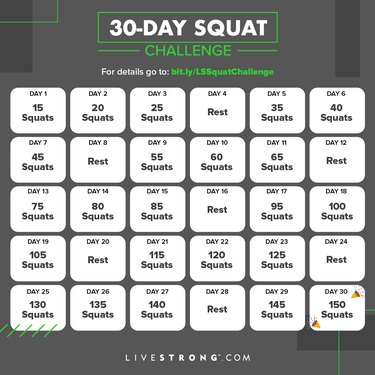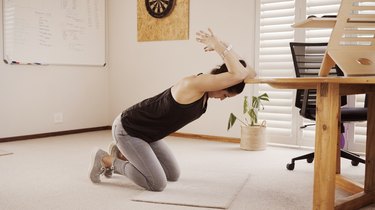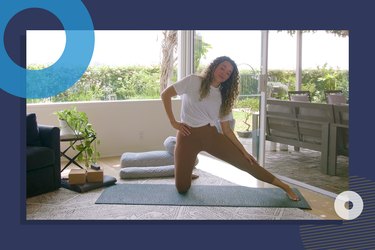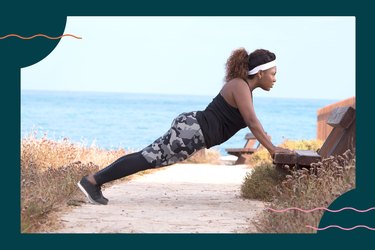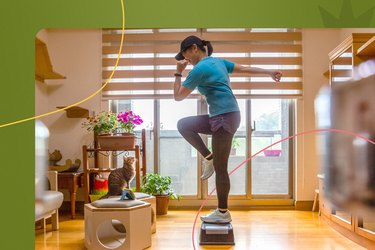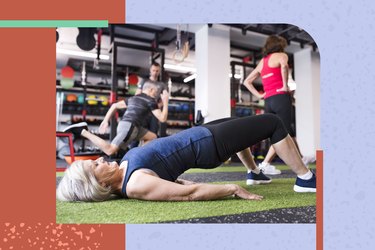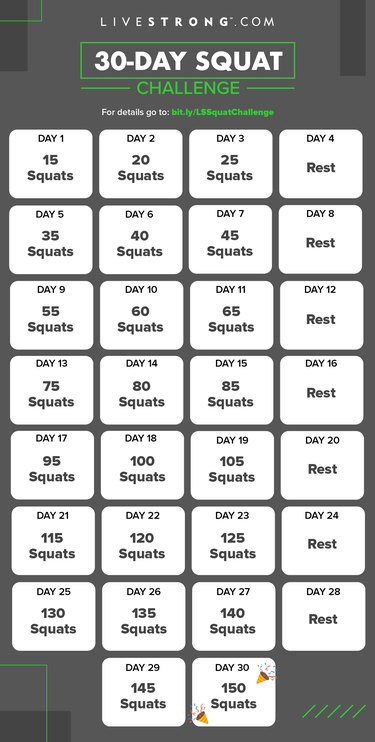
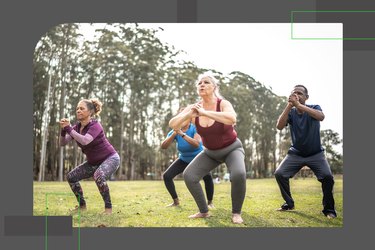
Want more powerful legs, sturdier knees or a stronger butt? Drop it like a squat! The squat is one of the best exercises (if not the best) for all these goals and more.
That's why we created this month-long challenge. To get you started, personal trainer and Fhitting Room instructor Ben Lauder-Dykes will help you perfect proper squat form, introduce you to modifications and variations and motivate you to finish what you start.
Remember: Aim high, squat low!
How the 30-Day Squat Challenge Works
We're completed our last official round of the Squat Challenge in October 2023, but you can start this challenge whenever inspiration strikes. And even though you can do it on your own, we recommend joining our Challenge Facebook Group for support from our community.
Each day, you'll do the number of squats listed in the calendar below, resting every fourth day. (Your legs will need the break!) You'll start out with 15 squats on Day 1 and finish with 150 on Day 30. Most days in between, you'll add 5 squats to the previous day's total, and on several of the days after rest days, you'll ramp it up and add 10.
Don't worry if that sounds like a lot: You can break your squats into as many sets as needed and try different variations to find what works for you. What matters most is that you get squatting.
The Challenge Calendar
Get a printer-friendly version of the challenge calendar here!
How to Join the 30-Day Squat Challenge
1. Keep Your Challenge Calendar Handy
Print or save the 30-day calendar above on your phone and use it each day to help you stay on track. Do the number of reps listed, then check off each day as you go.
2. Join Our Challenge Facebook Group
Our community of more than 58,000 members is here to support and motivate you through this challenge. Share your progress by posting photos or videos of your squats or simply tell the group how the day's reps went.
3. Perfect Your Squat Form
Before you start building up to lots of reps, make sure you're nailing proper squat form. Watch yourself in a mirror or have a workout buddy take a video for you.
How to Do a Proper Squat
- Stand with your feet hip-width apart. Turn your toes out to the sides slightly.
- Hinge at your hips and bend your knees (as if you were going to sit in a chair) while keeping your chest up.
- Either raise your arms out in front of you at shoulder height for balance or bring your hands up to your chest.
- Keep your feet flat on the floor and don’t arch your lower back.
- Now check your knees: They should be pointing in the direction of your toes (not collapsing in or bowing out).
- Once you’ve lowered as far as you can go comfortably while maintaining proper form, press through your feet to stand back up and squeeze your glutes at the top — then repeat!
Tip
A squat may seem like a simple, natural movement, but you always want to make sure your joints are aligned properly before you bust out 15 (or 150) in a row.
"The most common mistake I see with the squat is too much of a hip hinge without a bend in the knees," Lauder-Dykes says. "Other mistakes are shifting your weight either into the forefoot (which reaches the knees too far forward) or shifting of the weight back into the heel (which will limit the amount of ankle flexion that can occur)."
You can always break each day’s total reps into smaller sets. For example, on the first day, you might do 3 sets of 5 squats throughout the day. Try any combination that works for you.
4. Experiment With Squat Modifications
Squats are easily modifiable to match your fitness level. If you're a beginner or have knee issues, you have a few options.
"You can modify the squat by performing an isometric hold, also known as a 'wall sit,' so you get some load through those muscle groups," Lauder-Dykes says. You can also do an eccentric squat, which focuses on the descending part of the movement while your muscles are lengthening and eases a bit of the tension, or a box squat, which will help you judge how deep to lower down.
1. Isometric Hold (Wall Sit)
- Stand against a wall with your feet several inches away from the wall.
- Slide your back down the wall until your hips and knees form 90-degree angles.
- Keep your shoulders, upper back and head flat against the wall and distribute your weight evenly in both feet.
- Hold this position for 30 to 60 seconds.
2. Eccentric Squat
- Stand with your feet hip-width apart.
- Hinge at your hips and bend your knees (as if you were going to sit in a chair). Lower down slowly to the count of 3 to focus on the eccentric part of the squat.
- Stand back up more quickly, to a count of 1, and squeeze your glutes at the top.
- Repeat, lowering for 3 counts and standing up for 1.
3. Box Squat
- Stand in front of (and facing away from) a chair or box with your feet between hip- and shoulder-width apart and your toes facing forward or outward slightly.
- Keeping your feet flat on the floor and your back straight, push your hips back and down to sit down on the chair or box.
- Pause here for a brief moment, then press through your feet to stand back up.
Tip
If anything really starts to hurt and you're struggling with squats — even with modifications — stop and reassess. You might need to try some lighter exercises and stretches, like the clamshell or the figure four stretch.
5. Add in Some Squat Variations
Popular squat variations include sumo squats, where your feet are set much wider than hip-width apart, and squat jumps, where you explode off the ground once you reach the bottom of the squat.
Experienced athletes can also consider adding weight, either with dumbbells held at your shoulders or sides or a barbell across your chest or back. Just make sure your form is flawless before attempting these progressions, and don't add too much weight at once.
6. Take Advantage of Your Rest Days
All work and no rest makes for some very sore and overworked quads and glutes. So, when you see "Rest" on your calendar, follow the schedule!
"Rest is important for two reasons," Lauder-Dykes says. "One is that rest helps us recover from fatigue so that when we work out again we can train at a high level. The other reason is that we need time for our bodies to go through the recovery stage to see adaptations."
Rest days are when your muscles actually get stronger. Working out causes micro tears in your muscle fibers, and taking time off allows them to repair and grow in the process.
On your off days, show your muscles some love by doing some glute stretches or foam rolling. And get your heart pumping with a little light cardio. Walking, hiking, swimming and biking are all great options.
Check out these ideas for how to spend your days off:
7. Keep It Up
During this month-long challenge, you'll do lots of squats and probably try a few variations to target different muscles in your legs and butt. It's only natural to want to harness that momentum and keep your progress going.
For a well-rounded lower-body routine (pun absolutely intended), try some other great glute exercises, as well.
"Glute bridges, lunges and some core movements like planks, dead bugs and bird dogs are great additions to a lower-body program," Lauder-Dykes says. "These exercises challenge similar muscle groups in slightly different ways."
Don't forget to celebrate making it to the end of the 30-Day Squat Challenge. Let us know how it went in our Challenge Facebook Group.
When you're ready, keep your momentum going with a new challenge, such as:
Tip
You can do any of our challenges on your own whenever you want, or you can visit our Challenges page to see what we have planned for the full year.

